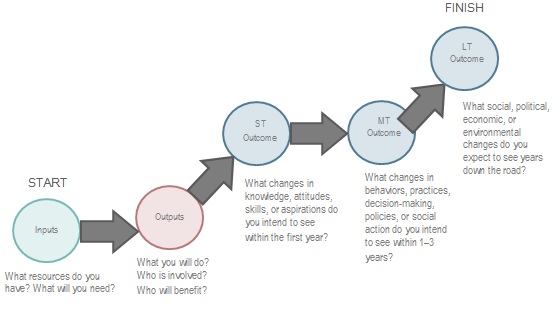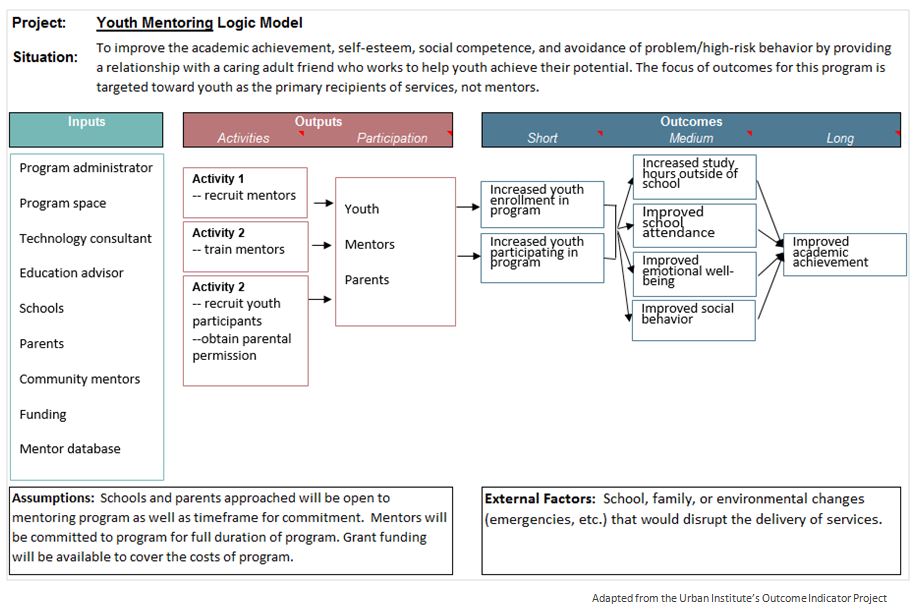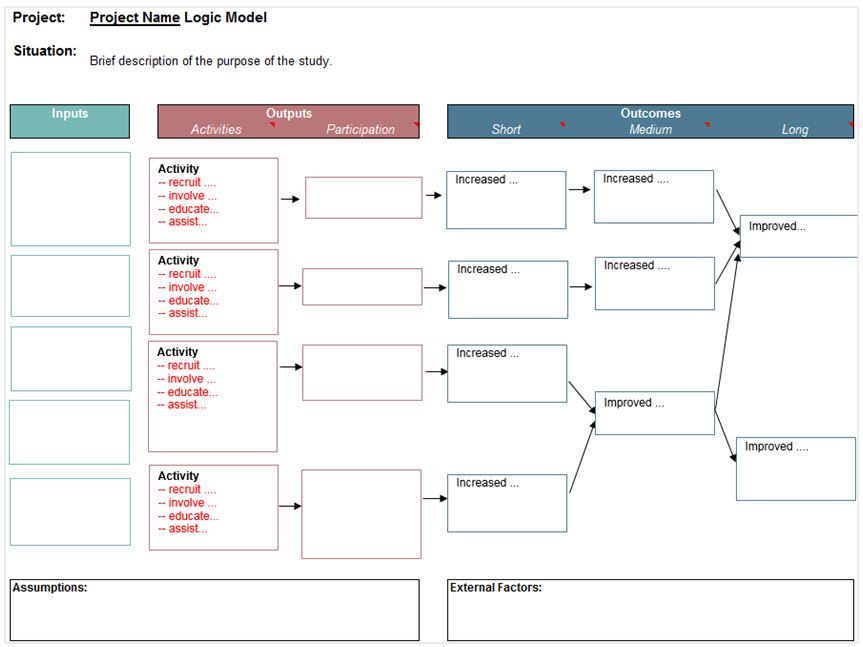How do you develop a Logic Model?
Truth be told, there are a lot of incredible resources already available on the topic of logic models. We are not reinventing the wheel, but repackaging it so that it is a little less daunting. Hopefully, you will read this within the context of the other white papers available.
What is a Logic Model?

A logic model is a framework that visually lays out how your program is intended to work and the rationale behind it. It provides a theory of the change you intend to make through the various aspects of your program or project and links the activities with the intended outcomes. Logic models (often referred to as log frames, logical frameworks, program theories, or outcomes sequence charts) are excellent preparation tools and are best completed before your program or project is implemented so that everything falls in line with your goals. It also provides a very clear avenue for both process and outcome evaluations.
Think of it as a roadmap. Would you want to start out on a road trip without a map?
Logic models essentially map out what outcomes you want to aim for and what social impact you want to see through your program—from start to finish. Start with what resources you have, what you will do, who is involved, and who will benefit; then state what you intend to be the short-term, medium-term, and long-term impact.

What are the elements?
Even though the content is the same, some things may be categorized slightly different depending on the sources you choose to consult.
- Inputs are the resources you have to do the work. This may include staff, time, materials, money, equipment, volunteer time, facilities, research, partners, etc.
- Outputs are the goods and services delivered - the program activities that are immediately quantifiable (numbers of people served, etc.). Outputs can be considered as the:
- What we do. Activities are the actions that the program will take (what it does with the resources). This may include the processes, tools, events, technology, workshops, etc. included in program implementation. [Note, this is often visually depicted before outputs.]
- Who we reach. Participation may include beneficiaries, clients, agencies, etc.
- Outcomes are the results or changes that come from the program. These changes may be:
- Short-term in that they affect knowledge, awareness, skills, and attitudes [LEARNING].
- Medium-term in that they affect behavior, practice, decision-making, policies, and social action [ACTION].
- Long-term in that they create greater social, political, economic, and environmental impact [CONDITIONS].
- Assumptions are the beliefs we have about the program, those involved, and how we believe the program will work.
- External factors are the elements outside the program that may influence the program or its results.
Since there are different ways these can be categorized, there are various ways you can set them up. We have provided an example of our preferred way at the end of this document, using an adaptation of the Urban Institute’s Youth Mentorship program.
How do you read it?
Logic models show a chain of events or sequences from left to right. It should be understood that if one thing happens, then the next thing (on the right) would happen.
If inputs (resources) are available to the program, then program activities (outputs) can be implemented; if program activities are implemented successfully, then certain outcomes can be expected.
Why do it?
Mapping out a proposed program enables you (and your stakeholders) to understand how their investments can contribute to achieving your program goals, ultimately leading to program improvements. In other words, they help position your programs for success.
According to the W.K. Kellogg Foundation Handbook (2004), logic models can be used in:
- Program design and planning
- Benefits: Finds “gaps” in the theory or logic of a program and work to resolve them.
- Criteria for program success: Program goals and objectives and important implications are well defined ahead of time.
- Benefits: Builds a shared understanding of what the program is all about and how the parts work together.
- Criteria for program success: Program goals and objectives are both plausible and possible.
- Benefits: Finds “gaps” in the theory or logic of a program and work to resolve them.
- Program implementation
- Benefits: Focuses attention of management on the most important connections between action and results.
- Criteria for program success: Relevant, credible, and useful performance data can be obtained.
- Benefits: Focuses attention of management on the most important connections between action and results.
- Program evaluation and strategic reporting
- Benefits: Provides a way to involve and engage stakeholders in the design, processes, and use of evaluation.
- Criteria for program success: The intended users of the evaluation results have agreed on how they will use the information.
- Benefits: Provides a way to involve and engage stakeholders in the design, processes, and use of evaluation.
When is it completed?
Ideally, a logic model is completed during the program planning stage. But, it is never too late to develop one, even if your program is already running. More often than not, you will find it extremely beneficial. You may find that some activities do not necessarily align with the ultimate goal of the program. You have to decide whether to change your activities to achieve the
outcomes you want or change the expected outcomes to relate to the activities you have in place. Either way, it brings focus.
The good news about this process is there is no right way or wrong way to develop a logic model. The context in which you use it will dictate to what level it needs to be developed. If used for implementation or evaluation, the model should be more fleshed out. For complex programs, you may need several logic models.
What do you do now?
Get your key program people together and begin to draft your logic model. It may take several drafts to get it right.
Although you read the logic model from left to right, you develop it from right to left (backwards).
- Start with your outcomes – what change do you want to see? Long-term, medium-term, and short-term? Write these as change statements (things increase, decrease, etc.).
- Identify what outputs will bring about these changes. Specifically, note what activities are planned in order to solve problems or build assets. These may include the number of workshops held, materials distributed, classes taught, program participation rates, meetings held, etc. Who will these activities be aimed at?
- List the resources, or inputs, that you will need in order to accomplish these activities.
- Check your logic model against the checklist provided at the end of this document.
After you have completed your logic model, set indicators to measure program success. This element is discussed in the Program Evaluation Whitepaper series.
Logic Model Framework (example)

Logic Model Framework (blank)

Logic Model Checklist
|
Questions |
Yes |
Not Yet |
|
|
1. |
A variety of audiences are taken into consideration when specifying credible outputs, outcomes, and impacts. |
|
|
|
2. |
Target participants and/or partners are described and quantified as outputs (e.g. 100 teachers from 5 rural high schools). |
|
|
|
3. |
Events, products, or services listed are described as outputs in terms of a treatment or dose (e.g. 30 farmers will participate in at least 3 sessions of program, or curriculum will be distributed to at least 12 agencies). |
|
|
|
4. |
The intensity of the intervention or treatment is appropriate for the type of participant targeted (e.g. higher-risk participants warrant higher intensities). |
|
|
|
5. |
The duration of the intervention or treatment is appropriate for the type of participant targeted (e.g. higher-risk participants warrant longer duration). |
|
|
|
6. |
Outcomes reflect reasonable, progressive steps that participants can make toward longer-term results. |
|
|
|
7. |
Outcomes address awareness, attitudes, perceptions, knowledge, skills, and/ or behavior of participants. |
|
|
|
8. |
Outcomes are within the scope of the program’s control or sphere of reasonable influence. |
|
|
|
9. |
It seems fair or reasonable to hold the program accountable for the outcomes specified. |
|
|
|
10. |
The outcomes are specific, measurable, action-oriented, realistic, and timed. |
|
|
|
11. |
The outcomes are written as change statements (e.g. things increase, decrease, or stay the same). |
|
|
|
12. |
The outcomes are achievable within the funding and reporting periods specified. |
|
|
|
13. |
The impact, as specified, is not beyond the scope of the program to achieve. |
|
|
|
14. |
Major activities needed to implement the program are listed. |
|
|
|
15. |
Activities are clearly connected to the specified program theory. |
|
|
|
16. |
Major resources needed to implement the program are listed. |
|
|
|
17. |
Resources match the type of program. |
|
|
|
18. |
All activities have sufficient and appropriate resources. |
|
|
Source: W.K. Kellogg Foundation Logic Model Development Guide, 2004
Sources
From ‘Candidate Outcome Indicators: Youth Mentoring Program,’ The Urban Institute, URL: http://www.urban.org/sites/default/files/youth_mentoring.pdf
From ‘Logic Model,’ University of Wisconsin-Extension: Program Development and Evaluation, URL: http://www.uwex.edu/ces/pdande/evaluation/evallogicmodel.html
From ‘Logic Model Development Guide,’ W.K. Kellogg Foundation, URL: http://www.smartgivers.org/uploads/logicmodelguidepdf.pdf
From “Developing a Plan for Outcome Measurement: Chapter 3 Logic Models”, URL: http://www.strengtheningnonprofits.org/resources/e-learning/online/outcomemeasurement/default.aspx?chp=3
